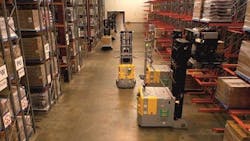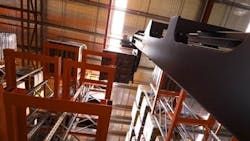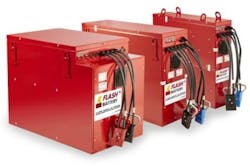Laser Guided Vehicles: The Next Step in Manufacturing Sustainability
Laser-guided vehicles (LGVs) are increasingly used in a growing number of manufacturing and distribution facilities, and for good reason. Compared to conventional lift trucks, LGVs provide a more consistent throughput of pallets; less damage to racking, raw materials, and merchandise; reduced labor requirements, and lower cost of operation.
Although recognized as a more sustainable option to lift trucks, the latest high-performance LGVs for pallet movement pack a lot of improvements in battery performance, energy use, vehicle uptime, and CO2 reduction, and enable a more integrated and space-optimized facility, making these LGVs serious systems in any facility seeking to upgrade its energy sustainability initiatives.
Technology advances in automated manufacturing and distribution have enabled a more integrated approach to the operation of material handling systems, which, in turn, has provided significant advantages for increased throughput, system uptime, and a better ROI. Along with this technological evolution, an accelerated capability for streamlined energy management, energy efficiency, and sustainability has also become possible, allowing ambient temperature, deep freeze, and chilled distribution facilities to better manage their power draw, energy use, systems integration, and overall operational costs.
In recent years, several material handling manufacturers have gone back to the drawing board and re-engineered many of their systems from the ground up to improve energy efficiency and sustainability, while maintaining these systems' load-carrying capability. One of these systems is laser-guided vehicles (LGVs), which, at least one manufacturer has significantly improved the performance of lithium batteries to keep its LGVs operating on the floor longer, even in challenging deep-freeze temperatures, while increasing battery life, and reducing battery recharging time and energy draw.
These LGVs, operating with highly sophisticated real-time controls, have enabled their integration with plant-wide packaging, storage, and distribution functions, effectively optimizing plant footprint and throughput, thereby enhancing sustainability initiatives.
Laser-Guided Vehicles
Laser-guided vehicles enable significant efficiencies in manufacturing and distribution. They improve production flow by bringing material to the operators, thereby cutting cycle times, and eliminating wait, walk, and search time. They reduce work-in-progress inventory. They cut labor costs by eliminating simple jobs related to material and movement, and permit reassignment of those workers to areas where they can add more value to the facility. LGVs virtually eliminate product damage with gentle handling of loads, and provide flexibility in process flow and throughput, as needs change.
LGVs provide for the movement of pallets between integrated functions in manufacturing and distribution. Interfacing with multiple systems, they enable reliable raw material and product handling with near-zero potential for product damage.
Using a combination of logic software and wireless navigation, LGVs can perform tasks that are not possible with other transport systems—such as the uniform movement and positioning of pallet loads to within a fraction of an inch of their designated targets, without noise, and with a high degree of safety for workers and their operational environment.
Latest Evolution of LGVs
The most recent automation developments in laser-guided vehicles for pallet movement enable warehouse operators and plant production supervisors to optimize for system flexibility, modularity, and scalability.
Many types of LGVs exist for use in different industries, but for a large number of applications in manufacturing and distribution, LGVs are used for pallet movement.
Four types of LGVs are commonly employed:
- Fork AGVs
- Lift-deck/unit-load AGVs
- Conveyor-deck AGVs
- Tugger AGVs
Designed to handle various pallet types—such as CHEP, EURO, Blockpallet, and Stringer—with load requirements up to 3,400 pounds, these LGVs can accommodate single and double-deep racking with a telescoping fork. Using a satellite remote unit, lane depth can also be extended.
Transporting heavy pallet loads, however, imparts huge forces upon these vehicles, resulting in significant maintenance and power requirements to keep LGV fleets functioning. The latest generation of LGVs, however, incorporates design, navigation, sensor, power, and control improvements that significantly streamline their prior operational performance.
An increasing number of supply chain manufacturers require 24-hour operation at maximum throughput in lights-out facilities. Today's latest generation of LGVs has been designed to efficiently meet and exceed these requirements.
A perfect example of this new evolution of laser-guided vehicles is E80's latest LGVs designed for pallet movement. E80, a multinational leader specializing in creating automated solutions for companies that produce fast-moving consumer goods, particularly in the food, beverage, and tissue sectors, has been a manufacturer of LGVs for almost three decades. Some of the company's latest technology advances have made LGVs attractive for sustainability, particularly with reduced energy consumption through enhanced lithium flash-battery technology and wireless induction charging.
Conventional Battery Technologies for LGVs
A key factor in LGV operation is battery performance, which directly influences energy usage. Options for battery power in LGVs are predominantly lead acid and lithium chemistries.
Lead Acid Batteries
The most conventional power source used in LGVs has been, and still is, lead acid. But lead is heavy, and these batteries require extensive maintenance, they are slow charging, and perform poorly in extreme sub-zero temperatures.
Lithium Ion Batteries
Lithium-ion batteries have changed much of this, however. A Lithium-ion solution, for example, with the capability of putting out 140 amp hours (Ah) of power would weigh about 150 pounds. Compare this to a lead acid battery putting out the same power, but weighing 700 pounds.
A lithium-ion phosphate battery will recharge 4x faster, and deliver 4x the life compared to lead acid. Typical lead acid recharge cycles max out at about 1,000, while lithium-ion phosphate is closer to 4,000 cycles.
Some of the latest technological advances in lithium-ion chemistries have made LGVs attractive due to reduced energy consumption. One of these is lithium Flash Battery technology.
The Latest Lithium Flash Battery Technology
Introduced for use with LGVs by E80, lithium Flash Battery technology, developed by Flash Battery Srl, provides a higher level of performance than other batteries for industrial vehicles.
Flash Battery technology uses the safest and most stable chemistry available, lithium-iron phosphate (LiFePO4), which is cobalt-free (material with high environmental impact) and delivers well-defined performance and long-term stability. Having a very constant discharge voltage, Flash Battery technology allows the LGV to maintain the same performance at every state of charge.
The cells in a lithium battery are not all the same and have small differences in capacity, internal resistance, and self-discharge. These differences lead to an imbalance among them. The response of conventional systems is to perform long balancing charges several times a week, which translates into dozens of hours a week of LGV downtime at charging stations.
To avoid these problems and keep efficiency high, Flash Battery Electronics employs a patented high-power balancing system, with active and passive modes, 20x faster than conventional balancing. This allows the cells to be equalized in just a few minutes once every 2 to 3 weeks. Only one lithium Flash Battery is required for each LGV, with an expected lifetime ranging from 6 to 10 years depending on the consumption of the specific plant.
Supporting the performance of LGVs using Flash Battery technology, E80's Flash Data Center daily monitors and controls every battery of the fleet integrated system to ensure the LGV network maintains its battery potential in peak performance to maintain plant uptime and efficiency.
The control electronics in the lithium Flash Battery keep it balanced and efficient, eliminating the need for regular maintenance. The remote monitoring system enables the condition of the battery to be determined at any time while reporting any malfunctions.
Lithium Flash Battery technology eliminates problems connected with lead-acid batteries, including high maintenance costs, low efficiency below 75%, short battery life, inability to partially charge, and the cost of charging salts and exhaust vacuum systems. A single lithium Flash Battery is required per LGV, compared to two batteries needed with traditional lead-acid LGV applications. Lead-acid batteries will last anywhere from 2 to 3 years, compared to lithium Flash Battery technology which is proposed to last 8 to 10 years.
Reduced Energy Usage
The importance of reducing energy consumption and better management of energy utilization becomes a more critical issue as energy costs escalate, and manufacturing and logistics operations are pressured to lower operating costs without loss of productivity. This is driving the evolution of more energy-efficient material handling systems, along with the analytic tools and controls to optimize their operation.
LGVs with lithium flash-battery technology, combined with wireless induction charging, can deliver a considerable reduction in energy usage when compared to LGVs using lead-acid batteries.
When compared to pallet conveyors which require considerable energy to power their motors, the power requirements for LGVs using flash-battery technology are up to 30% less to move the same load weight over the same distance in a manufacturing or distribution facility.
Integrated-Plant Supports Sustainability
The smooth functioning of LGVs is dependent on their control system, which has the task of coordinating the orders received from the plant's process system or warehouse management system, or ERP, then directing the work for the automated guided vehicles.
But the latest generation of LGV control systems can do much more. For example, Smart Integrated Logistics (SM.I.LE80) from E80 ensures the integrated and automated management of systems and flows, communicating with production lines, palletizers, and wrappers, as well as coordinating the movement of pallets in the warehouse, through to shipping. The entire logistics flow of the manufacturing and distribution environment can be centrally managed from an integrated logistics software platform that ensures the efficient integration and optimization of all operations. Such a control system also guarantees total product traceability and safety throughout the facility's supply chain.
These controls optimize system flexibility, modularity, and scalability. The net result is better utilization of the facility's footprint. Off-site storage can now be consolidated back into the main plant, reducing vehicle travel and energy needed to power the off-site locations, particularly in chilled and deep-freeze storage—supporting sustainability.
Control systems like SM.I.LE80 also enhance predictive maintenance and cloud-based condition-based maintenance by providing better visibility of the operating state of every machine within the integrated environment, in real time. This not only means improved system uptime but also supports sustainability. More efficiently operating machines make better use of energy consumption, and reduce leakages of lubricants and other chemicals into the environment, particularly with rotating equipment.
These high-performance LGVs for pallet movement, along with their control systems, pack extreme improvements in battery performance, energy utilization, and vehicle uptime. These factors make LGVs serious systems in any manufacturing or distribution facility seeking to upgrade its sustainability initiatives.
About the Author
Jim McMahon
CEO, ZebraCom, Inc.
Jim McMahon writes on industrial, manufacturing, and technology solutions. His features have appeared in more than 3,500 trade and business publications worldwide.




